Overcoming Common Pitfalls in Trial Presentations

Effective Trial presentations are the cornerstone of legal persuasion, and even the most well-prepared attorneys can fall victim to common pitfalls that can undermine their case. Luckily, there are actionable tips you can use to deliver a more effective and persuasive trial presentation.
Overloading with Information
Attorneys often believe that including every possible detail will bolster their case. However, this can lead to confusion and fatigue among jurors, causing them to miss key points.
To effectively support your narrative, prioritize clarity by focusing on the most major pieces of evidence. Use simple language and avoid legal jargon so your argument is accessible and understandable to those without legal training. Incorporate visuals such as charts, diagrams, or timelines to simplify complex information. Always ask yourself, “If I were a juror, would I be able to follow this?”
Neglecting the Power of Storytelling
While the legal field is inherently fact-driven, neglecting the human element of storytelling can make a case seem cold and unrelatable. Jurors are more likely to engage with and remember a story than a list of disjointed facts.
Craft a compelling narrative that ties your evidence together. Every case has a story—whether it’s about justice, wrongdoing, or redemption. Start with a strong opening statement that sets the stage and introduces the characters (the plaintiff, defendant, and key witnesses). Use the trial presentation to build your narrative, highlighting how each piece of evidence fits into the larger story. Encourage the jurors to empathize with your client by presenting their experiences and emotions.
Underestimating the Importance of Visual Aids
Some attorneys believe that their oral arguments alone are sufficient to persuade a jury. However, people are generally more receptive to information when it is presented visually. Relying solely on verbal explanations can result in jurors missing or misunderstanding key points.
Incorporate well-designed visual aids to complement your verbal arguments. Use slides, videos, and animations to illustrate key concepts. For example, in a personal injury case, a medical animation can help the jury understand the extent of the injuries better than words alone. Be mindful of the quality of your visuals—poorly designed graphics can be distracting.
Failing to Rehearse Adequately
Even the best-prepared cases can fall flat if the presentation is delivered poorly. A lack of rehearsal can result in stumbling over words, mismanaging time, or failing to respond effectively to objections.
Treat your trial presentation like a performance by rehearsing it multiple times—both alone and in front of colleagues who can provide constructive feedback. Pay close attention to your pacing, tone, and body language, as these non-verbal cues significantly impact how your message is received. To further improve your preparation, consider using a mock trial to practice responding to objections and interruptions, ensuring you’re ready for any possible scenario.
Ignoring the Jury’s Perspective
Attorneys sometimes become so focused on their arguments that they forget to consider how the jury perceives the information. This can lead to disconnects, where jurors either lose interest or become confused.
Constantly gauge the jury’s reactions throughout your presentation. Are they engaged, or do they seem lost? Adjust your delivery as needed. Use questions or hypothetical scenarios to involve the jury and encourage them to think critically about the evidence. For example, “Imagine you were in the defendant’s position—how would you have reacted?” This technique not only engages the jury but also reinforces your narrative.
At Legal Media Experts, we specialize in impactful trial presentations. Our team ensures your message resonates with the jury, turning complex cases into compelling stories. Contact us to learn more.